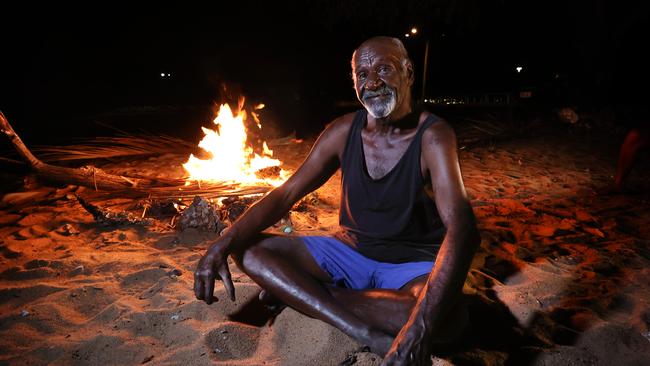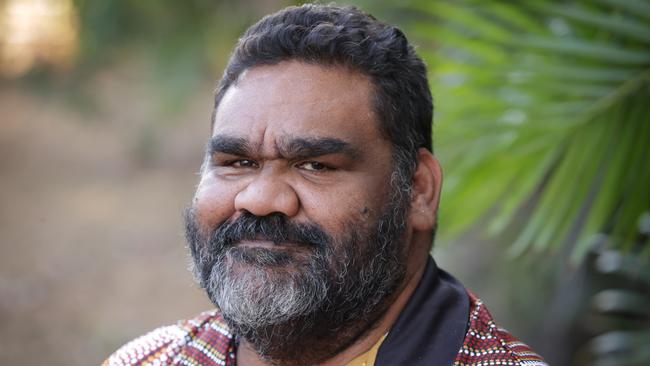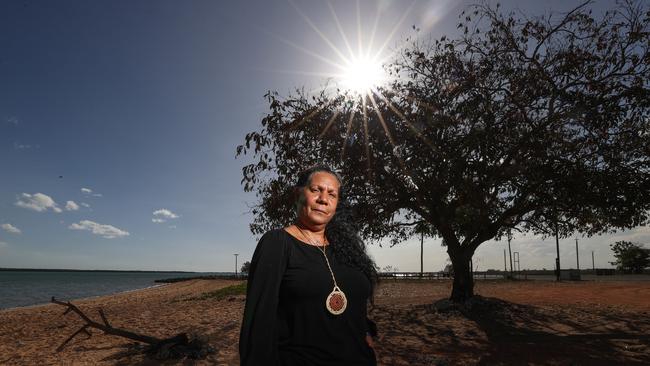No homes, no jobs, no opportunities: Why ‘closing the gap’ is getting harder
In this tiny Australian town things were meant to be improving, but hardships are getting worse not better. It faces issues that locals say “city folk” couldn’t truly understand.
QLD News
Don't miss out on the headlines from QLD News. Followed categories will be added to My News.
It’s sunset in Napranum, a remote Indigenous community south of Weipa in Cape York.
Red dust cakes everything here, which explains the dazzling shades of the dropping orb, as well as the massive bauxite mining operations that ring this town of adversity.
Beneath the almond tree on the foreshore, dead coconut fronds are piled for the coming fire. Brothers fish. Dogs wander. Birds call and ants bite.
Joseph Bosuen blends the old ways with the new. He will soon throw lines of root oysters on the fire, to pop open the shells to expose the tender meat inside.
He’s here every night – except a couple of months ago, when a crocodile materialised from the waters after dusk to gobble dogs on the shoreline, then launch itself at Bosuen’s camp fire site and feast on his nightly catch of salmon, barra and mudcrab.
Such attacks would be front-page news down south. But life and death exchanges with the wild are common here.
Anyway, they finally trapped the “cheeky bugger”, Bosuen merrily says, a ciggie in his mouth, a can in his hand.

Napranum is a dry Indigenous community, except that it’s not. Alcohol gets in readily, as do drugs, in a prohibitionist failing that afflicts many Indigenous communities across the nation.
Each community is unique; its own triumphs, its own challenges. Some here in Cape York, such as Napranum, have fought for their existence against mining companies and government neglect, in jarring chapters of raging paternalism and unthinkable separations.
Their languages were banned. Their movement was restricted, and their “half-caste” children were transplanted supposedly for their own good, in bastard policies which offend any modern lens.
Such communities now face the same kinds of challenges. Too little housing. Too much Western food. A lack of jobs and opportunities, which perpetuates what the official rhetoric likes to label as “poor outcomes”.
Closing the Gap is the ambitious national wishlist for change. In Napranum, as with elsewhere, some say the gap (first identified in the mid-2000s) has widened since the initiative targets were re-set a few years ago. They say hardships are getting worse, not better.
In the west of Cape York at Australia’s northern tip, where the crocodiles bask and the barra splash, and dinner is typically hunted with a spear, rod or firearm, the high-minded gesturing of Canberra and the capital cities doesn’t seem to matter much. The biggest battles, such as the grog, largely appear to lie within.
FIXING GAP LIKE ‘CHASING YOUR OWN TAIL’
A phone tower greets the visitor to Napranum after turning off the main road, where termite hills sprout by the hundreds. Abandoned cars command million-dollar views over the Embley River. A lone crow shrieks high in a tree. Metal bars on the council office windows hint of unrest.
There is innovation and aspiration here, as well as inertia and resignation. There are maybe a couple of suicides a year in this community of about 880. Life expectancy is low – a decade or more below the rest of Australia.
Unemployment in Napranum in 2021 was three times the national average at the time of 5.1 per cent. The median weekly household income was $788, well under half of the national figure. Those qualified to year 12 or higher sat on 28.6 per cent, again well under half the rest of Australia.
Chronic disease, domestic violence, and house overcrowding heighten the despair, which has run in cycles that start in early childhood and seems doomed to be perpetuated in a scarcity of resources and apparent absence of answers.
Local welfare counsellors lament. Today, four of them sit side-by-side near the entry to town, reinforcing each other’s expressed challenges of community life. They wring their hands. They care deeply, as so many do in these parts.

They offer fixes to the most pressing problems, but identify few lasting solutions.
One of them is Rex Burke, a former mayor of Napranum. He identifies gaps between investment and outcomes. He calls it “chasing your own tail”. Funding does not reach the people who need it most. And how do you change generational patterns of behaviour?
The aims are engagement and empowerment. But where does this begin? Where kids have little scope to focus on education? Where rates of self-harm and suicide remain steady? Where a lack of new houses in a growing community means 10 or more people might live in a two-bedroom home, as if to ensure that rates of domestic and family violence persist?
It’s widely agreed that “getting children young” is key. Teaching them to eat better. Educate them in Western schooling that bows to cultural heritages. Get them to year 12 and beyond, to pursue dreams of lifestyle and vocation.
These are obvious starting points for meaningful change. Yet each target is blocked by obstacles.
Lorna Bosen is armed with an infectious giggle as a frontline contact for kids in difficult times. For her, what does and does not happen in remote Indigenous homes drives the more dramatic measures, such as suicide, prison rates and poor health.
Children are cramped. They might lack school shoes, or a schoolbag, or food in a home where meagre incomes are squandered on vices.
There is nowhere to do homework. No space to call your own. Such children, she says, lack a sense of “value”.
Burke speaks of a national Indigenous housing program which wound up a few years ago. Over eight years, he says, 30 or more new homes sprung up in Napranum. Since then, there is a new home about once every two years.
Here’s the problem, he says, “because it all starts at home”.
“They don’t want to talk to a white person,” Bosen says of Indigenous kids. “They want to talk to an Indigenous person because they feel they know the dynamics in the community.” So the youngest kids, in their most formative years, tend to “suffer in silence”.
Val Bird has worked in Napranum for a few years. Her outsider’s perspective offers insight. “The issues in Indigenous communities are very complex,” she says. “I don’t think a lot of city folk really understand … It’s not as black and white as people think. And every community is very different.”

A COMMUNITY DARING TO DREAM OF SOMETHING BETTER
Dr Fiona Wirrer-George has “fire in my belly”. It stems from her grandmother, who trekked five days or more to Napranum in 1942, including a river crossing in a dug-out canoe.
Wirrer-George is a traditional owner, as well as director of family and community services at Napranum Aboriginal Shire Council. Her Nana taught her languages, some now considered extinct, and she feels mandated to preserve them.
Like many here, she has come and gone to the relative bigness of Cairns, yet she always felt the yearning for “home”.
Wirrer-George is an emblem of success, a sturdy bridge who links within to the outside, a keeper of the traditional flame who has excelled in the outside ways. She’s also a damn good talker.
Napranum has improved since her childhood, she says, waving at the splash park and basketball courts.
Up to 12 tribes coexist here, fashioning a local language that draws on each as well as English. Yes, they can squabble, but fights are not reserved for Indigenous people, she says, arguing that all humans are complex and stubborn.
She agrees with Burke that overcrowded houses “interfere with the empowerment of young people”. And she laments the patterns of incarceration whereby young men fall into a cycle which sadly promotes time in jail as a “new form of initiation”.

“People have lost their way through displacement,” she says, citing the longer history of Napranum as a case study in the suppression of autonomy and culture.
“Displacement is the biggest thing that has impacted on our people.”
Yet she also brims with hope. The old can and must blend with the new. The “connection with country” is paramount; locals must be able to “pick up a fishing spear and spear that stingray at low tide”.
But she also speaks of her recent PhD graduation, when some locals asked what a PhD was and marvelled at her ceremonial “hat”.
She has a higher education, “whitefella way”.
But she also honours Indigenous epistemology and her grandmother’s search for understanding.
“I think the message is getting out there and I think this younger, current generation now is acknowledging and recognising and pursuing,” she says.
They can dare to dream of something better, but “also go beyond dreaming because dreaming is kind of stagnant, right? You got to take that step, jump in that river and just see where that river will take you.
“There’s an element of life that’s mysterious.
“You’ve just got to give yourself over to participation.”
Originally published as No homes, no jobs, no opportunities: Why ‘closing the gap’ is getting harder



